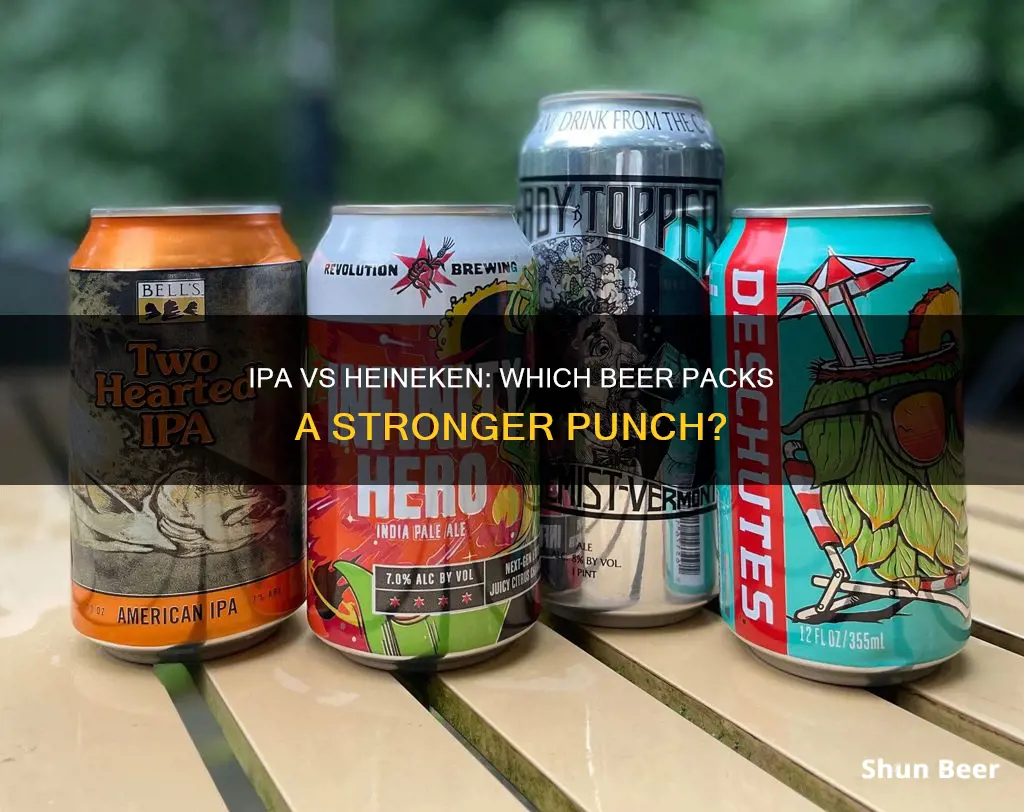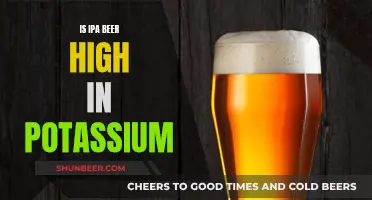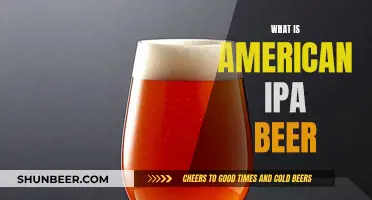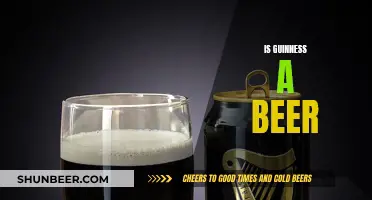
Beer lovers are often spoilt for choice when it comes to picking a drink, with the IPA vs Heineken debate being a common dilemma. Heineken, a Dutch pale lager beer, has a signature green bottle and a distinctive taste. With 5% alcohol by volume, it is known for its light and crisp flavour, making it a popular choice worldwide. On the other hand, IPAs, or India Pale Ales, are characterised by their strong, hoppy flavours and higher bitterness levels due to the use of aromatic hops. They typically have a deeper amber hue and a warming effect in the mouth due to their higher alcohol content. With such distinct characteristics, the choice between Heineken and IPA ultimately comes down to personal preference for taste, appearance, and the unique experience each beer offers.
What You'll Learn
- Heineken is a Dutch pale lager beer with 5% ABV
- Heineken's green glass bottles do not protect the beer from sunlight, which can result in a skunky taste
- IPAs are top-fermenting beers, brewed at a higher temperature, and have a deeper amber hue
- Heineken is the second most popular beer brand in the world, serving 25 million beers daily in 192 countries
- Heineken is the major sponsor of the UEFA Champions League, the UEFA Super Cup, and the Rugby World Cup

Heineken is a Dutch pale lager beer with 5% ABV
Heineken has since become a globally recognised beer brand, sold in 192 countries as of 2022. The company claims to serve 25 million beers every day worldwide and is the world's second-largest brewer. Heineken has been featured in numerous Hollywood films, including the James Bond franchise, and has sponsored major sporting events such as the UEFA Champions League and the FIA Formula One World Championship.
In terms of taste, Heineken has a distinct flavour that lingers longer on the palate and is brighter compared to similar beers like Stella Artois. While it has its fans, some reviewers have described Heineken as slightly skunky with a distasteful aftertaste. However, others have praised its taste and quality, calling it a "great beer" and a "good European beer".
Heineken also offers a non-alcoholic version called "Heineken 0.0", which was launched in 2017 and received positive feedback for its taste, resembling the full-alcohol version. The brand is committed to reducing harmful drinking and has taken steps to promote responsible consumption, such as their "When You Drink, Never Drive" advertising campaign.
American IPA Beer: What's the Deal?
You may want to see also

Heineken's green glass bottles do not protect the beer from sunlight, which can result in a skunky taste
Heineken is a Dutch pale lager beer with 5% alcohol by volume. It is the fourth-most-popular beer in the US and the second-most-valuable beer brand in the world. Heineken's green glass bottles are iconic, but they don't protect the beer from sunlight, which can result in a skunky taste.
The colour of glass beer is bottled in can affect the "skunking reaction" that occurs when hops are exposed to UV light. This reaction can cause the beer to take on a skunky or "marijuana-like" character due to the production of the chemical compound 3-methyl-2-butene-1-thiol, or "3-MBT". Brown bottles offer better protection against UV light than green bottles, and fully frosted bottles are even better. Clear bottles offer no protection at all.
Some brewing companies avoid the "lightstruck problem" by using specially formulated hop extracts that do not react with UV light to create 3-MBT. However, Heineken is not one of these companies, and its green bottles do not effectively protect the beer from UV light exposure. As a result, Heineken can develop a skunky taste if exposed to sunlight or other sources of UV light.
This skunky taste is not always considered a bad thing. Some people enjoy the slightly skunky taste of Heineken and similar green-bottled beers. However, it can be off-putting for those who are sensitive to the strong skunk musk aroma that can develop.
To avoid the skunky taste in Heineken, it is best to store the beer in a cool, dark place and avoid exposing it to direct sunlight or other sources of UV light.
The Hipster IPA: Fad or Forever?
You may want to see also

IPAs are top-fermenting beers, brewed at a higher temperature, and have a deeper amber hue
India Pale Ales (IPAs) are top-fermenting beers, brewed at a higher temperature, and have a deeper amber hue.
IPAs are top-fermenting beers, brewed at a higher temperature than lagers, and have a more pronounced flavour. The top-fermenting process involves using yeast that works at higher temperatures, typically around 65 to 70 degrees Fahrenheit, which results in a deeper amber hue in the final beer. This is in contrast to lagers, which are bottom-fermenting beers brewed at colder temperatures, usually around 50 to 55 degrees Fahrenheit, resulting in a lighter colour.
The higher brewing temperature of IPAs also affects the flavour and aroma of the beer. The warmer temperature speeds up the activity of the yeast, leading to increased fermentation byproducts such as esters and fusels, which contribute to the stronger flavour and higher alcohol content often associated with IPAs. The higher temperature also accentuates the hop bitterness and aromas in the beer, resulting in a more intense and bitter taste compared to lagers.
In addition to the brewing temperature, the type of yeast used also plays a role in the distinct characteristics of IPAs. IPAs are fermented with bacteria, while lagers are fermented with yeast. The use of bacteria in IPAs contributes to the higher alcohol content and unique flavour profile.
The combination of higher brewing temperatures and different yeast or bacteria contributes to the deeper amber hue of IPAs. The warmer temperature and longer brewing time allow for more malt and hops to be released, resulting in a darker shade. The hops, when combined with malt, contribute to a darker colour, resulting in an amber or reddish-brown beer.
The deeper amber hue of IPAs is one of the most visible differences between them and lagers, which are typically bright yellow or golden in colour. The darker shade of IPAs is a result of the brewing process and ingredients used, specifically the higher temperature and higher amount of hops.
While the deeper amber hue is a characteristic feature of IPAs, it is important to note that not all IPAs will have the same colour. The appearance of IPAs can range from a deep amber to a dark reddish-brown, and some may even have a lighter golden appearance. However, the majority of IPAs will have a darker shade compared to lagers due to the brewing process and ingredients used.
Beer and Potassium: IPAs and Their High Potassium Content
You may want to see also

Heineken is the second most popular beer brand in the world, serving 25 million beers daily in 192 countries
Heineken's success can be attributed to its early wins, innovative spirit, and strategic marketing. Within the first year of its founding, Heineken brewed 5,000 barrels of beer, and by 1875, it had won its first award, the Medaille d'Or in the International Exhibit of Marine and River Industries in Paris. This win propelled Heineken into the international market, and it soon became the biggest beer exporter to France.
The company's commitment to innovation is evident in its adoption of Bavarian lager and the development of its signature "A-yeast" by chemist Hartog Elion in 1886. This unique yeast remains a key ingredient in Heineken's recipe, contributing to its rich, balanced taste and subtle fruity notes.
Heineken's marketing strategy has also played a pivotal role in its global success. The brand is deeply ingrained in sports culture, with sponsorships of major sporting events such as the UEFA Champions League, Formula 1 racing, and rugby union. Additionally, Heineken has leveraged influential brand ambassadors, including celebrities and influencers, to connect with its target audience.
Heineken's social media presence, particularly on Facebook, has also contributed to its popularity. With 24 million followers, the brand engages users through real-time campaigns, storytelling, and geotargeted content.
The company's expansion into new markets, such as Asia, Africa, and Latin America, has further solidified its global presence. Heineken was the first legally sold beer in the U.S. after Prohibition, and it has established a strong foothold in countries like Nigeria, where nearly half of its export profits came from in the 1950s.
In recent years, Heineken has adapted to evolving consumer trends by launching Heineken 0.0, a successful alcohol-free beer that has opened up new markets and reinforced the brand's commitment to innovation.
Heineken's widespread popularity, combined with its strong brand recognition, cements its place as the second most popular beer brand in the world, serving millions of beers daily across the globe.
Guinness Beer: Does It Contain Fish?
You may want to see also

Heineken is the major sponsor of the UEFA Champions League, the UEFA Super Cup, and the Rugby World Cup
Heineken is a major sponsor of some of the world's most popular sporting events, including the UEFA Champions League, the UEFA Super Cup, and the Rugby World Cup. Heineken has been a Champions League sponsor since 1994, and in 2023, the brand renewed its sponsorship for the 2024-27 cycle. This extended deal will take Heineken's sponsorship of the UCL to 33 years. Heineken is also a sponsor of the UEFA Women's Champions League and the UEFA Women's Euro national team competition.
In addition to its involvement with football, Heineken has a long and rich heritage in rugby. The brand has been a worldwide partner of the Rugby World Cup for over 20 years, beginning with South Africa 1995 and continuing through Japan 2019. Heineken is also the title partner of the Heineken Champions Cup and a partner of several World Rugby Sevens tournaments.
Heineken's sponsorship of these major sporting events provides the brand with significant exposure to a global audience. Through its association with the UEFA Champions League, UEFA Super Cup, and Rugby World Cup, Heineken connects with fans and consumers worldwide, fostering brand awareness and loyalty.
The sponsorship deals typically include various marketing and promotional rights, such as presenting the UEFA Champions League trophy tour, activating sponsorships through marketing campaigns, and integrating the brand into the events' fabric. Heineken leverages these opportunities to engage with consumers, create memorable experiences, and reinforce its position as a prominent supporter of international sports.
The Oldest Beer: Guinness's Historical Journey
You may want to see also
Frequently asked questions
IPA stands for Indian Pale Ale. It was invented by a London-based brewer for English troops in India. It has a higher alcohol content and more hops, giving it a bitter taste.
Heineken is a Dutch pale lager beer with 5% alcohol by volume. It is one of the most popular lagers in the world.
The main difference is in their fermentation process and hop profile. IPAs are top-fermenting beers, while Heineken is a bottom-fermenting lager. IPAs are brewed at a higher temperature and have a deeper amber hue, while Heineken is lighter in colour.
A typical lager, such as Heineken, averages about 5% ABV, whereas IPAs (double and triple IPAs) can reach as high as 10-15% ABV. Therefore, IPAs are generally stronger than Heineken.
This is subjective and depends on individual taste preferences. Heineken is known for its light profile, clean taste, and dry finish, while IPAs are known for their strong, hoppy flavours and higher bitterness level.







